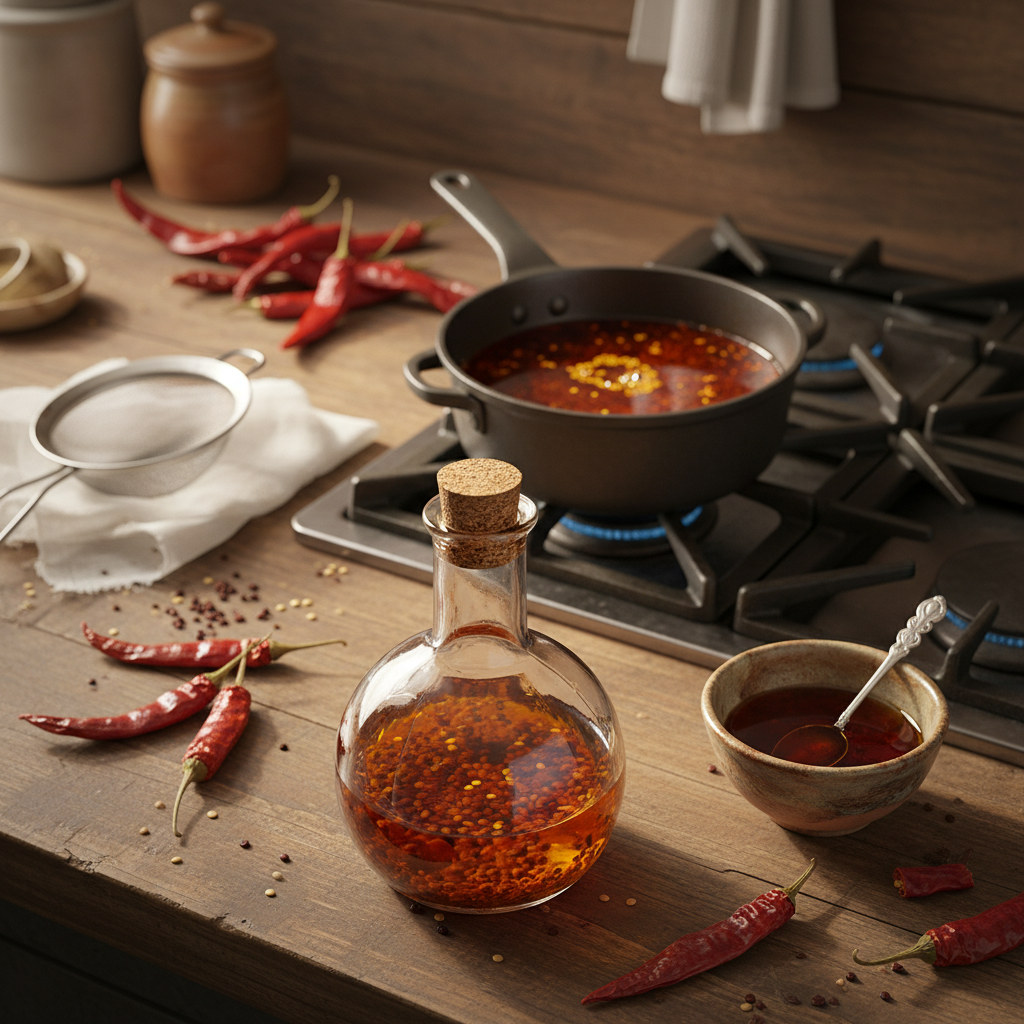Hey there, fellow food adventurers! If you’re anything like me, your kitchen isn’t just a place to cook; it’s a laboratory of flavors, a sanctuary of scents, and sometimes, a little bit of a mad scientist’s lair. Today, we’re diving into one of my all-time favorite kitchen projects: crafting your very own chili seed oil. Trust me, once you’ve made this, you’ll wonder how you ever lived without it.
I remember the first time I stumbled upon the idea of chili seed oil. I was making a big batch of fermented hot sauce, and I had all these beautiful, vibrant chili seeds left over. My initial thought was to just discard them, but then a little voice (probably my ier food blogger) whispered, “What if…?” A quick search revealed that while chili *oil* made from the flesh of chilies is common, extracting flavor specifically from the seeds was a niche but fascinating concept. The idea of capturing that unique, earthy, slightly nutty aroma, distinct from the sharp heat of the capsaicin-rich flesh, was instantly appealing. And let me tell you, the journey from that “what if” to my perfect recipe has been a delicious one!
This isn’t just about adding heat to your food; it’s about adding a *dimension* of flavor. It’s about taking something often discarded and transforming it into a golden, aromatic elixir. So, grab your apron, get ready to get a little bit spicy, and let’s make some magic together!
Why Chili Seed Oil? Beyond the Flesh
You might be thinking, “Isn’t chili oil just… chili oil?” And while that’s true in a general sense, chili *seed* oil offers a distinctly different profile. Most traditional chili oils focus on the dried flakes or fresh flesh of the chili, which primarily extract capsaicin (the heat compound) and a more direct, fruity, or smoky chili flavor. The seeds, however, are a whole different ballgame.
Through countless experiments in my own kitchen, I’ve learned that chili seeds, when properly infused, release a complex bouquet of aromas. You get those lovely earthy undertones, a subtle nuttiness, and a more rounded, aromatic kind of heat that’s less about scorching your tongue and more about a warm, pleasant glow. It’s a fantastic way to utilize parts of the chili that often go to waste, adding a layer of sophisticated flavor to your dishes that you simply won’t get from store-bought chili oils.
Think about it: the seeds are where the plant’s life force begins. They hold a unique concentration of essential oils and compounds that, when gently coaxed out, create something truly special. This oil isn’t just for fire-eaters; it’s for anyone who appreciates the nuanced beauty of the chili pepper.
The Art of Infusion: My Approach to Flavor Extraction
Infusion is an art, really. It’s about patience and understanding how to coax delicate flavors from ingredients without burning them or losing their essence. My approach to chili seed oil centers around a low and slow method, ensuring maximum flavor extraction without any bitterness or scorched notes that can arise from high heat.
I’ve tried various methods – quick high-heat infusions, cold infusions, even a slow cooker approach. Through trial and error, I’ve found that a gentle stovetop infusion at a controlled, low temperature yields the most consistent, flavorful, and aromatic oil. It’s about giving those precious seed compounds enough time to mingle and dissolve into the oil, transforming it into a golden, spicy treasure.
A crucial part of this “art” is understanding the role of temperature. Too high, and you risk burning the seeds, leading to a bitter, unpleasant taste. Too low, and the infusion might not be potent enough. My goal is to find that sweet spot where the oil gently bubbles, signaling that the magic is happening without any harshness. And don’t worry, I’ll walk you through exactly how to achieve that perfect temperature later on!
Gathering Your Arsenal: Ingredients & Equipment You’ll Need
Before we embark on our spicy journey, let’s make sure you’ve got everything you need. Think of this as your mise en place for flavor crafting!
The Stars of the Show: Chili Seeds
- Source: You can get chili seeds in a few ways.
- From Fresh Chilies: If you’re processing fresh chilies for another recipe (like hot sauce or salsa), simply scoop out the seeds. Make sure to thoroughly wash them to remove any remaining flesh or pith, then dry them completely. This is crucial for preventing spoilage! I usually spread them on a baking sheet and let them air dry for a few days, or use a very low oven (around 150°F / 65°C) for a couple of hours until they’re brittle.
- From Dried Chilies: If you’re using whole dried chilies (like Guajillo, Arbol, or even Kashmiri for color), you can break them open and extract the seeds. Again, ensure they’re completely dry and free from any rehydrated flesh.
- Purchased Seeds: You can also buy chili seeds specifically for planting or cooking. Just ensure they are food-grade and not treated with any chemicals.
- Type of Chilies: This is where you get to personalize! I’ve had great success with a mix of hotter seeds (like Habanero or Scotch Boet for a fiery punch) and milder, more aromatic ones (like Fresno or even Bell Pepper seeds for a sweeter, earthier base). Experimentation is key to finding your signature blend. Just remember, a lot of the capsaicin is in the pith, not just the seeds, so the oil often gets an aromatic heat more than a pure fiery blast.
The Liquid Gold: Your Choice of Oil
- Neutral Oils are Best: You want an oil that will let the chili seed flavor shine, not compete with it. My top recommendations are:
- Grapeseed Oil: Very light, high smoke point, neutral flavor. My personal go-to.
- Canola Oil: Affordable, neutral, widely available.
- Sunflower Oil: Another excellent neutral option.
- Light Olive Oil (not extra virgin): If you want a slight olive oil undertone, but make sure it’s “light” or “pure” olive oil, as extra virgin can have too strong a flavor and a lower smoke point.
Essential Equipment
- Heavy-Bottomed Pot or Saucepan: This is crucial for even heat distribution and preventing scorching.
- Fine-Mesh Sieve or Strainer: To separate the seeds from the infused oil.
- Cheesecloth (optional but recommended): For an extra-fine strain, ensuring your oil is perfectly clear.
- Heat-Resistant Spatula or Spoon: For stirring.
- Clean, Sterile Glass Bottles or Jars: With airtight lids for storage. Sterilize them by washing thoroughly with hot soapy water, rinsing, and then either boiling them for 10 minutes or ruing them through a hot dishwasher cycle. Let them air dry completely.
- Thermometer (optional but helpful): An instant-read or candy thermometer can help you maintain the ideal low temperature.
My Tried-and-True Chili Seed Oil Infusion Recipe
Alright, let’s get down to business! This is the method I’ve perfected over many batches, ensuring maximum flavor and a beautifully aromatic oil.
Ingredients:
- 1/2 cup dried chili seeds (your chosen blend)
- 2 cups neutral oil (grapeseed, canola, or sunflower recommended)
Instructions:
- Prepare Your Seeds: If your seeds aren’t already dried, ensure they are absolutely bone dry. Any moisture can cause the oil to spoil or splatter dangerously when heated. If you want to enhance their nutty flavor (which I highly recommend!), gently toast them in a dry pan over medium-low heat for 3-5 minutes, stirring constantly, until fragrant. Be careful not to burn them! Let them cool completely.
- Combine & Heat: Pour the neutral oil into your heavy-bottomed saucepan. Add the dried, cooled chili seeds.
- Low and Slow Infusion: Place the saucepan over the lowest possible heat setting on your stovetop. We’re aiming for a gentle, slow infusion, not frying. The oil should be warm, with very small, subtle bubbles occasionally appearing around the seeds. If you have a thermometer, aim for a temperature between 180°F – 220°F (82°C – 104°C).
- Stir Occasionally: Stir the mixture every 15-20 minutes to ensure the seeds are evenly coated and releasing their flavors into the oil.
- Infuse for Flavor: Continue this gentle infusion for at least 1.5 to 2 hours. For an even more potent flavor, you can extend this to 3 hours. The oil will gradually take on a beautiful golden-red hue, and your kitchen will smell wonderfully aromatic.
- Cool Down: Once you’re satisfied with the infusion, remove the saucepan from the heat. Let the oil and seeds cool down completely in the pan to room temperature. This crucial step allows the flavors to continue developing and deepening as the oil cools.
- Strain & Filter: Place your fine-mesh sieve over a large, clean bowl or measuring cup. Carefully pour the cooled oil and seeds through the sieve, allowing the oil to collect below. For a crystal-clear oil, line the sieve with a double layer of cheesecloth and pour the oil through again. You might need to gently squeeze the cheesecloth to extract every last drop of that precious oil.
- Bottle & Store: Once strained, transfer your homemade chili seed oil into your clean, sterile glass bottles. Seal them tightly.
Tips for Success & Common Pitfalls to Avoid
Having made my fair share of batches, I’ve gathered some wisdom to share:
- Patience is a Virtue: Don’t rush the infusion process. Low and slow truly is the way to go for the best flavor.
- Bone-Dry Seeds: I caot stress this enough – any moisture in your seeds will lead to a shorter shelf life and potential spoilage.
- Don’t Overheat: High heat will burn the seeds, resulting in a bitter flavor, and can also degrade the oil. Keep that flame low!
- Sterilize Everything: Cleanliness is next to godliness in the kitchen, especially when making infused oils. Sterilized bottles and equipment prevent contamination.
- Storage is Key: Store your chili seed oil in a cool, dark place (like a pantry) to preserve its flavor and extend its shelf life. A well-made, properly stored chili seed oil can last for several months, often up to 6 months, sometimes even longer. If you ever add fresh aromatics (like garlic or herbs) to infused oils, it’s safer to store them in the refrigerator and use them within a week to minimize botulism risk, but since we are primarily working with dry seeds here, the risk is minimal.
- Taste Test Along the Way: Feel free to taste a tiny bit of the oil after an hour or so (once it’s cooled a bit) to gauge the flavor development.
- Experiment with Aroma Boosters: While this recipe focuses purely on seeds, once you’re comfortable, you can experiment by adding a few dried aromatics like a star anise pod, a small piece of dried ginger, or a couple of Sichuan peppercorns during the infusion for an extra layer of complexity. Just remember to strain them out with the seeds.
Beyond the Bottle: How to Use Your Homemade Chili Seed Oil
Now that you’ve got this liquid gold, what do you do with it? Oh, the possibilities are endless! Here are some of my favorite ways to enjoy my homemade chili seed oil:
- Drizzle Finisher: My absolute favorite! Drizzle it over noodles, rice, eggs, avocado toast, roasted vegetables, or even a simple bowl of soup right before serving. It adds that perfect aromatic warmth and a beautiful sheen.
- Marinades: Incorporate it into your marinades for chicken, pork, or tofu. It infuses a lovely depth of flavor.
- Dressings: Whisk it into your salad dressings for a subtle spicy kick. It pairs wonderfully with citrus or vinegar-based dressings.
- Stir-Fries: Add a splash to your stir-fries for an extra layer of complexity and aroma.
- Dipping Oil: Serve it in a small dish with some crusty bread for a flavorful appetizer.
- Pizza & Pasta: A few drops on your pizza slice or pasta dish can elevate it instantly.
The Joy of Homemade Flavor
There’s something incredibly satisfying about creating something so flavorful and unique right in your own kitchen. Making your own chili seed oil isn’t just about the end product; it’s about the process, the aroma that fills your home, and the pure joy of culinary exploration.
I genuinely hope you give this recipe a try. It’s a fantastic way to elevate your everyday cooking and add a bespoke touch to your meals. Plus, think of the bragging rights! You’ll be able to tell your friends, “Oh, this subtle, aromatic warmth? That’s my homemade chili seed oil.” Go on, unleash your ier flavor alchemist. Happy infusing!




